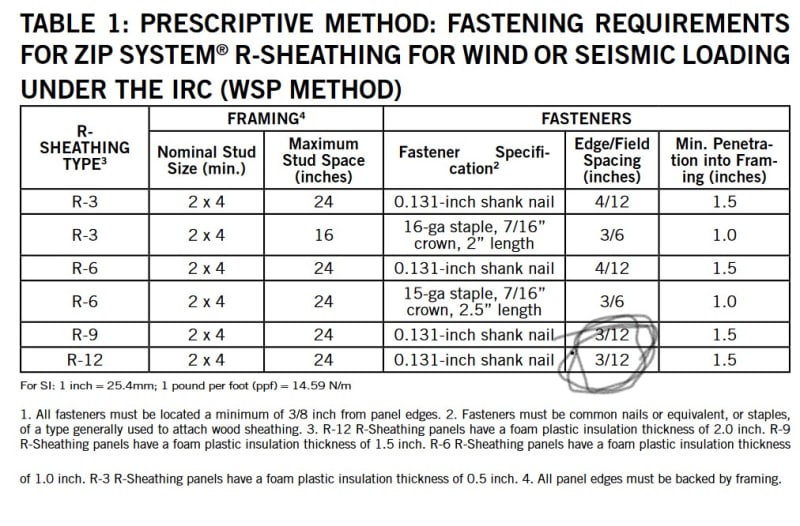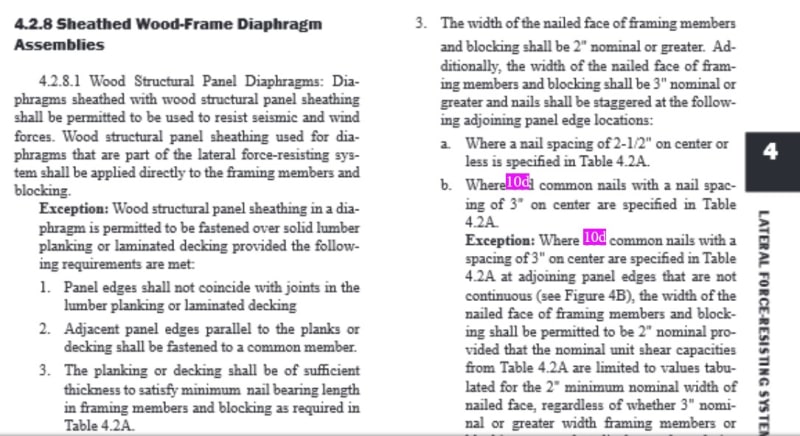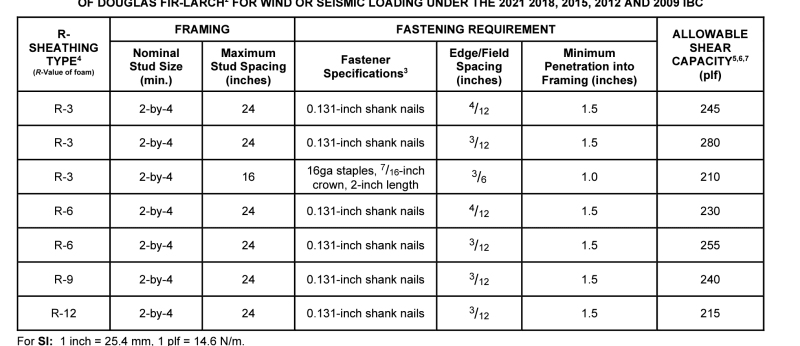Navigation
Install the app
How to install the app on iOS
Follow along with the video below to see how to install our site as a web app on your home screen.
Note: This feature may not be available in some browsers.
More options
Style variation
-
Congratulations MintJulep on being selected by the Eng-Tips community for having the most helpful posts in the forums last week. Way to Go!
You are using an out of date browser. It may not display this or other websites correctly.
You should upgrade or use an alternative browser.
You should upgrade or use an alternative browser.
Zip-R 3
- Thread starter XR250
- Start date
- Status
- Not open for further replies.
So.... 0.131" diameter is a 10d common, right? 1 1/2" penetration into the framing require per their Table 1 (non-engineered) but let's just keep following that. The 2 7/16" thick section and the 1.5" minimum penetration is roughly a 4" long nail. Note that a 4" nail is 1/16" "too long" to go 1 1/2" into the framing, so 1 9/16" penetration, PROVIDED the nail gun doesn't overdrive the fastener.

Anybody else see a problem here?

Admittedly, this is a "braced wall" nailing schedule, however.....

Anybody else see a problem here?

Admittedly, this is a "braced wall" nailing schedule, however.....
-
1
- #22
XR250 said:It sits on the PT sill plate -which is not even shown in those pics.
Ah. So cheat your floor framing (or wall framing if on a slab) so the sheathing lands on it rather than sitting next to it? I can buy that. And since you have to use other uplift restraint anyway, that's not an issue.
bookowski - my issue is the structural usefulness of the product. They have 3rd party testing reports for use in both prescriptive braced wall lateral systems and engineered shear wall lateral systems. If you look at the engineered tables, you'll see that you need crazy nailing patterns just to get capacities on par with some of the weakest 'normal' shear wall assemblies in the SDPWS. I'm in the mid-Atlantic near the coast. Most of work is just north of the 'hurricane prone region' line but some of it is inside it. Either way, beachfront homes make up a not inconsiderable portion of my workload. Minimal shear wall capacities won't cut it. I regularly have to specify 3" on center for 15/32" Structural I sheathing, use FTAO analysis, etc. to get these houses to work without introducing steel frames. ZipR makes those steel frames a guarantee on most houses that I work on.
If they didn't replace a critical structural element of the house with Styrofoam, I'd say these things are pretty neat. But they do. So I don't like them.
lexpatrie said:So.... 0.131" diameter is a 10d common, right?
I believe 10d common is 0.148".
Yeah, I searched versus looking in the actual NDS, my bad. So it's a 4" long 8d common nail. The comment about the splitting is dealt with in that sense, but the reality of the sheathing (and siding) hanging on the nails remains. They have details to isolate the bottom of the panel from the foundation, but it just makes the hanging even clearer.
I don't much care for the corner detail, either. In a weatherproofing/waterproofing sense.
Oh, and then the fastening guide wants a "shank" nail. I'm not sure that bright nail somebody found up there qualifies, let alone using a "bright" nail (no galvanizing) on the exterior, sure, on paper these nails are supposed to be dry. But reality? Even if we don't have direct water exposure, what about potential condensation on the nails from water vapor? Do you tape over the nails? Also, does anybody trust the installer to do the roller pressure on the tape for the joints?
I don't much care for the corner detail, either. In a weatherproofing/waterproofing sense.
Oh, and then the fastening guide wants a "shank" nail. I'm not sure that bright nail somebody found up there qualifies, let alone using a "bright" nail (no galvanizing) on the exterior, sure, on paper these nails are supposed to be dry. But reality? Even if we don't have direct water exposure, what about potential condensation on the nails from water vapor? Do you tape over the nails? Also, does anybody trust the installer to do the roller pressure on the tape for the joints?
I think it's a great product for buildings where only low capacity shear walls are needed or where shear resistance is provided by other means. Similar to you, I used this for some exterior walls that I reconstructed at my house. The low shear capacity in my case was more than adequate and likely much higher than the existing horizontal sheathing boards that I replaced. While setting the pieces and nailing them (by myself) was a pain, the fact that the product provides insulation, sheathing, and a vapor barrier in one product makes it well worth it. I made sure to take the time to properly seal and tape all the joints (which perhaps a contractor wouldn't have been so diligent with). The finished product resulted in a significantly more energy efficient space. I used the particular product with 1" of insulation and 1/2" sheathing.bookowski said:What's the beef against zip-r? Are you guys seeing problems?
Overall, if I was looking at Zip-R as only a structural engineer, I'd say it's not great, but for every other reason I'm a fan. I will say, though, that the R-12 with 2" of insulation is pushing it. Even as a homeowner with low shear demands, I'm not sure I'd want to use that.
- Status
- Not open for further replies.
Similar threads
- Replies
- 4
- Views
- 3K
- Locked
- Question
- Replies
- 7
- Views
- 3K
- Question
- Replies
- 0
- Views
- 3K
- Question
- Replies
- 4
- Views
- 3K
- Locked
- Question
- Replies
- 2
- Views
- 1K

